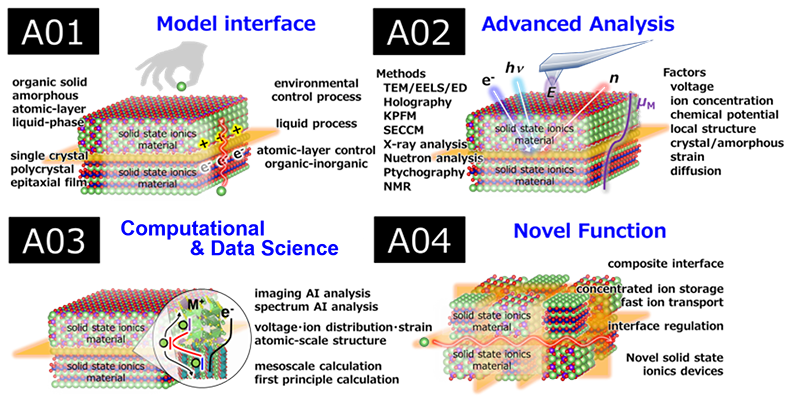Greetings

Solid-solid interfaces generate entirely new functions different from the intrinsic nature of each solid material. In this project, unique interfacial ion dynamics around the hetero/homo interfaces of solid state ionics materials (SSIM) are systematically investigated, and the goal is to establish design principles for fast ion transport and concentrated ion storage around interfaces, that is, “Interface Ionics”.
The “Interface IONCS” is closely related also to develop sustainable society. For example, “Interface IONICS” clarifies the issues of electrode/solid electrolyte interfaces in advanced energy storage devices such as all-solid-state batteries and all-solid-state capacitors, and provides clear guidelines of interface regulations for further improvements of the devices toward faster charge-discharge reactions and higher energy densities.
We would appreciate your support.
Principal Investigator
Nagoya University, Yasutoshi IRIYAMA
EventsArchive
-
Open International meeting 2022.03.30
-
Open International meeting 2022.03.29
-
Open International meeting 2021.03.10
-
Open International meeting 2021.03.09
-
Open International meeting 2019.09.24
-
Open Interface IONICS meeting 2019.09.17
NewsArchive
-
Outreach 2019.06.30
Research Outline
There are two types of SSIMs: insertion electrode materials (electrodes) and solid electrolytes. In the former, electrons or holes move faster than ions. In contrast, ions move faster than electrons or holes in the latter. When these two SSIMs combine, an equilibrium state is reached through the rearrangement of all charged carriers (electrons, holes, and ions). At equilibrium, their electrochemical potentials become equal. Consequently, the electrode/solid electrolyte interface realizes unique properties with each intrinsic SSIM due to factors such as space charge layer formation and mechanical relaxation (strain distribution) that provide unique interfacial ion dynamics (Fig. 1). The aim of this project is to investigate the physical and chemical modulations around interfaces in detail and establish interface design principles, which will make it possible to generate novel functions around interfaces. This project integrates chemistry, physics, advanced measurements, theoretical and data science, and material science. It consists of four research groups.
Gp-A01 fabricates model interfaces using materials such as single crystalline substrates and epitaxial thin films and investigates their interfacial ion dynamics. Gp-A02 analyzes the properties around the interface including the modulation and distribution of voltage, ion concentration, chemical potential, and local structure using advanced measurements. Gp-A03 clarifies the distribution of ions and electrons and their dynamics around the interface using multi-scale theoretical calculations and informatics analyses. Gp-A04 develops advanced materials with an emphasis on metastable phases with lattice defects and lattice strains by combining crystalline and amorphous SSIMs.








